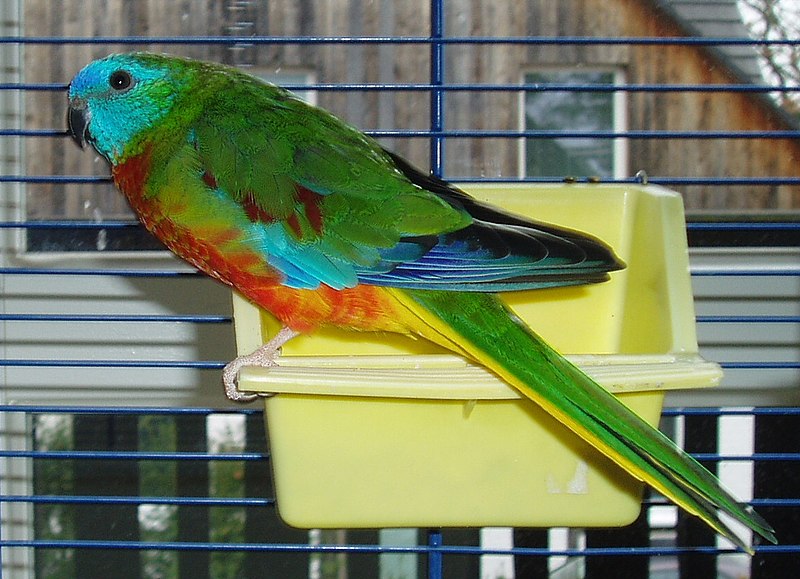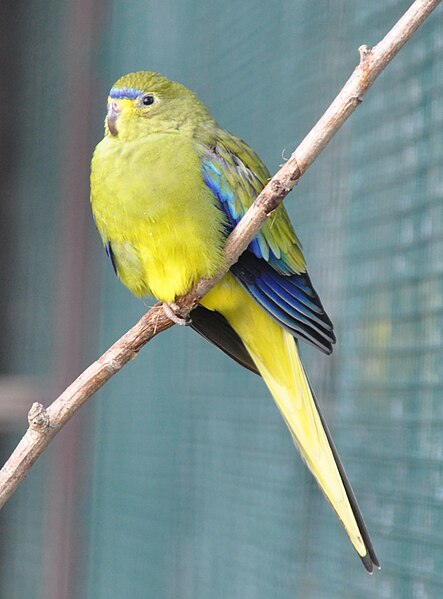 Australia’s Grass Parakeets (Genus Neophema) are so beautifully colored and graceful in flight, that it almost seems like they “should be” delicate and difficult to keep. Yet they are very hardy, fairly quiet with pleasant “songs” and quite confiding and easy to tame. Please see my article Introducing Australia’s Colorful Grass Parakeets to learn about their many good points. Today we’ll meet a few of the more popular species.
Australia’s Grass Parakeets (Genus Neophema) are so beautifully colored and graceful in flight, that it almost seems like they “should be” delicate and difficult to keep. Yet they are very hardy, fairly quiet with pleasant “songs” and quite confiding and easy to tame. Please see my article Introducing Australia’s Colorful Grass Parakeets to learn about their many good points. Today we’ll meet a few of the more popular species.
Splendid or Scarlet-Chested Grass Parakeet (Neophema splendida)
“Splendid” indeed – a perfect name for what some consider to be the most fantastically colored of all birds. Florescent blue, black, blue-green, bright green, scarlet and lemon yellow all appear in this South Australian beauty’s plumage.
Although not common in the arid scrub it calls home, the Splendid Parakeet is well-established in captivity – your first view of one will explain why! Like several of its relatives, this parakeet has the odd habit of flying about and singing as dusk falls. Its erratic flight, best seen in an outdoor aviary, has led some to describe it as a “multi-colored bat”.
In common with other Grass Parakeets, the Splendid is at its best in an aviary, but adjusts well to large indoor cages. Pairs breed readily and usually make very good parents.
Bourke’s Parakeet (Neophema bourkii)
The Bourke’s Parakeet’s subtle, understated beauty stands in contrast to the Splendid’s flamboyance, but it is no less attractive. Violet, pink and blue suffuse the soft gray of its feathers, giving a very unique effect.
 Bourke’s Parakeet hails from Central Australia. A calm demeanor suits it to moderately sized cages, especially of it is given ample out of cage time to exercise.
Bourke’s Parakeet hails from Central Australia. A calm demeanor suits it to moderately sized cages, especially of it is given ample out of cage time to exercise.
A generally quiet bird (all Grass Parakeets are considered to be so), Bourke’s Parakeet is said to be Australia’s third most popularly kept Psittacine, trailing only the Cockatiel and Budgerigar.
Turquoisine or Turquoise Grass Parakeet (Neophema pulchella)
Southeastern Australia’s Turquoise Grass Parakeet is just as “splendid” in coloration as the Splendid Parakeet. Most Grass Parakeets interbreed readily – hybrids of these 2 species must be something to see!
This 8 ½ inch rainbow-hued bird inhabits grasslands and open woodlands from Central Queensland through New South Wales to Victoria and occurs on Kangaroo Island as well.
Quiet and somewhat subdued for the most part, pairs become unusually aggressive to other birds during the breeding season. While this aggression is sometimes also turned against their owners, Turquoise Parakeets usually regain their sweet dispositions once the young are on their own.
Elegant Grass Parakeet (Neophema elegans)
Another aptly named bird, the Elegant Parakeet does indeed portray the quality for which it was named. Its colors – olive green with a cobalt blue band on the forehead and wing edges – are not overly bright but mix together very nicely.
Male Elegant Grass Parakeets are well known for their amusing courtship displays, for which they seem to prefer a sunlit “stage”. Wild individuals often live in close association with people, and captives are quite bold and willing to interact with their owners if given the opportunity.
Further Reading
You can read more about Grass parakeets and other Australian birds on the Unique Animals of Australia Website.
A video of a beautiful male Splendid Grass Parakeet singing is posted here.
Elegant Parrot image referenced from wikipedia and originally posted by Quartl
Turquoise Parrot image referenced from wikipedia and originally posted by DanWeh
 That Bird Blog – Bird Care and History for Pet Birds
That Bird Blog – Bird Care and History for Pet Birds





Australian Grass Parakeet are really lovely pretty birds. But apparently most of them are kept as aviary birds rather than as pets. I personally love the Bourke Parakeet, the pretty pink feathers is so unique, but it does make them looks a little “girlish”.
Hello Bryan, Frank Indiviglio here.
Thanks for your interest in our blog and sorry for the delay in responding.
I agree on Bourke’s; they seem to be one of the most popular of the group. I like to see them in aviaries – they can adapt to cages, but definitely are at their best when they can fly about.
Good luck and please keep me posted.
Best regards, Frank Indiviglio.
Hey Frank, Nice posts. I was unaware of these three types of Parakeets. That Grass Parakeet is something else. I personally own three parakeets (budgies) and they all range in color from albino white to a yellow/green greywing, and I even have a blue/white pied female. All three are very unique looking and my do they have their own personalities.
A tip for parakeet pet owners, stick to one bird at a time. If you buy just one bird at a time it will bond with you rather than the other bird and will be easier to traing and will be more likely to start talking.
Hello Coby, Frank Indiviglio here.
Thanks for your interest in our blog and the kind words.
It is often easier to train a single budgie or other parrot, there are important considerations – they are very social birds, and a few hours each day of interaction with a person does not fulfill their needs. Please check my article on keeping single budgies for more on some of the factors that should be considered.
Good luck and please keep me posted.
Best regards, Frank Indiviglio.
Is there a place I can purchase a cd of bourkes or australian grass parakeets in general singing?